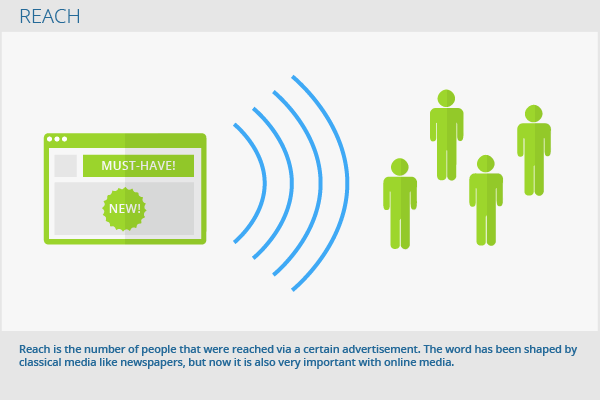Reach
In advertising, the term reach refers to the number of persons reached by an advertising campaign. The term "reach" is used as a KPI by both classical media such as newspapers or radio and TV as well as by online media. The reach measurement can be carried out in different ways depending on the medium.
Meaning of this figure
Today, reach is a key success indicator for operators who want to know the extent to which their content is perceived. Even more important, however, is the range of reach for advertising customers. For example, before they book an advertisement in a newspaper or online portal, they want to know the reach of the particular medium. This is the only way they can assess how many people they can potentially reach with their advertisement.
Definition
There are various notions for the reach that need to be differentiated:
GROSS-REACH
For the gross reach all contacts of a customer with the medium are included. It is not taken into consideration how many people are really reached. The gross-reach is the most imprecise way of measuring reach.
NET-REACH
You get the net reach after removing double and multiple contacts of the gross reach. So this number is naturally lower that the gross reach.
QUALITATIVE GROSS AND NET REACH
To get the qualitative reach the concerning target group is taken into consideration. The following example explains this: An advertising customer places an ad for vegetarian meat substitutes in a daily paper. The paper is sold 50,000 times, but only every tenth reader is a vegetarian. According to this the qualitative gross reach is 5,000.
Printmedia Reach
The reach of print media has been shrinking for years. In 2014, around 70% of all Germans read classic papers. Local newspapers had the biggest readership. However, the trend from print to online media is becoming increasingly noticeable. Even with magazines, the trend towards smaller editions is noticeable, thus generating less reach. In 2017, for example, 83 of the 100 highest-circulation stocks lost another year-on-year increase in reach.
Social Media Reach
Facebook, and other social media offer advertisers great possibilities to spread their advertising message. But, also in social media the reach has to be considered. The more friends a user has and the more sites he likes, the more posts will be in his Facebook Newsfeed. So per day there could run hundreds or thousands of postings. It’s impossible for a usual user to recognize all, so with a special algorithm Facebook selects which posts are relevant for which user and only shows those. If postings of advertisers are not considered to be relevant, e.g. because the user doesn’t interact with them, they get hidden and the advertisement loses physical reach. Therefore, more and more advertisers try to increase their reach e.g. with the following measurements:
- Booking of sponsored post or Facebook advertisement (fee-based)
- Better timing of postings
- Regular publications with added value
- Checking of statistics on the success or failure of single postings
- More interacting with the users
Online Marketing Reach
The reach of Online Marketing is easier to check then e.g. of a daily paper. So if a person buys a paper, the advertiser doesn’t know if he actually reads the Ad. So online advertisement offers more differentiated evaluation options. With corresponding tracking and analysis tools it’s possible to work out how long a user visited a website and which activities he made afterwards. The exact consequence and the achieved reach can be defined more clearly. In online marketing, reach is usually measured in the form of unique visits or page impressions.
Cost per Thousand (CPM)
If the reach is used as a basis to calculate the price of an advertisement, the CPM is the key figure. For media planning this price shows how much an advertiser has to pay to get 1,000 contacts. Also, for online the CPM is a common parameter. But in this case the basis are so-called Ad-Impressions. Mostly, this is the frequency of how often an ad is shown, e.g. a banner.
Measuring Reach
Reach with print media is measured on the one hand by circulation, and on the other by surveys. AGOF determines valid pay for TV companies. In online business, web analytics tools such as Google Analytics play an important role in measuring reach.
Web Links

